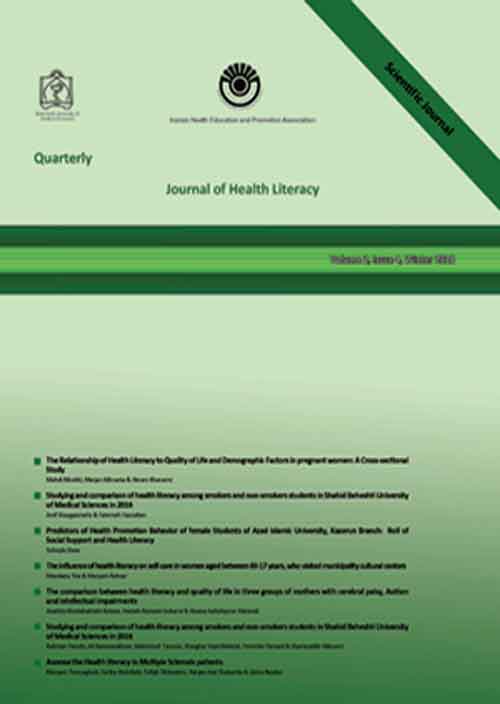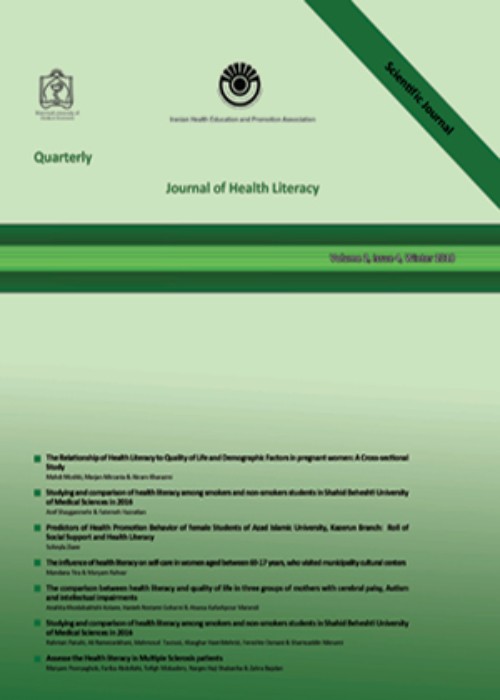فهرست مطالب

Journal of Health Literacy
Volume:5 Issue: 4, Winter 2021
- تاریخ انتشار: 1399/12/28
- تعداد عناوین: 7
-
-
Pages 9-16Background and Objective
Health literacy is the degree to which an individual has the capacity to obtain, process, and understand basic health informa tion and services to make appropriate health decisions. Women’s health literacy is an important skill to par ticipate in the preven tion and promo tion of public health. This study was aimed to inves tigate women's health literacy and some related factors in Mashhad.
Materials and MethodsThis is a descrip tive study that was performed on 400 women referring to cultural centers of Mashhad municipality in 2018-2019. A personal informa tion ques tionnaire and a short form of func tional health literacy ques tionnaire in adults were used to assess the data. Sta ti s tic so ftware (SPSS 16) were used to conduct descrip tive tests (Frequency, mean, and standard devia tion) and analy tical sta ti s tics (Kruskal-Wallis, Mann-Whitney, and ordinal logis tic regression).
ResultsThe results of this study showed that 16.5% of women par ticipants had inadequate health literacy ، 19.8% had border health literacy, and 63.7% had adequate health literacy. Health literacy was signi ficantly related with educa tion, and with the improvement of educa tion level, the score of health literacy also increases. However, no signi ficant rela tionship between health literacy and age, income, marital status, and employment was observed.
ConclusionMore than one-third of women had inadequate or border health literacy. Considering the important role of women in family and community health and the impact of health literacy on this important role, it is necessary to design and implement educa tional programs to promote health literacy skills in them.
Keywords: Health Literacy, health promotion, Women -
Pages 17-30Background and Objective
The quality-of-life index is like a graph that describes the situation of all people living in a region or country and includes economic, social, and human variables. The results of various studies have shown that quality of life can be affected by various individual, social and environmental factors. This study aims to summarize the results of research conducted in the country with a focus on factors affecting the quality of life in the general population of Iran.
Materials and MethodsThis study was a systematic review based on reviewing relevant document. All articles that published in Iranian electronic databases (example Magiran, SID, and Noormags) were examined via keywords related to the quality of life and its effective factors in the general population. Studies that met the inclusion criteria were evaluated in all years.
ResultsIn this research, 46 studies were reviewed from 2008 to 2018. Based on the results of the studies, some contextual and social variables such as; age, level of education, occupation, income, social capital, marital status, housed hold Size, socio-economic status, and social participation of individuals introduced as factors related to the quality of life. Also, the quality of life in the women studied was not very high.
ConclusionSince the results of studies confirm that the impact of various individual, environmental and social factors on the individual’s quality of life, the dynamism and continuous changes in the quality of life over time, and the different opinions of different scientific groups about the indicators affecting quality of life. It is suggested that more attention must be paid to research on this structure, individual and social components that affect individual’s quality of life.
Keywords: Quality of life, quality of mental life, quality of objective life, Effective factors -
Pages 31-40Background and objective
It is unclear how health literacy is associated with health-related quality of life. The aim of this study was to examine the mediating role of treatment regimen adherence between health literacy and health-related quality of life (HRQoL) in older adults with type 2 diabetes mellitus (T2DM).
Material and methodsIn this cross-sectional study, a multi-stage cluster sampling method was used to recruit 300 diabetic patients aged 60 years and over with diabetes. The abbreviated version of the Test of Functional Health Literacy in Adults (S-TOFHLA) and the Swedish Health-related Quality of Life (SWED-QUAL) instrument were used to measure health literacy and HRQoL, respectively. In addition, the Morisky Medication Adherence Scale (MMAS), the diet and exercise adherence questionnaire, were used to assess treatment regimen adherence. The four steps of Baron and Kenny’s procedure were implemented to test the mediation hypotheses.
ResultsThe mean age of the respondents was 64.92 years. In addition, the mean of the respondents’ health literacy score was 52.82. The prevalence rates of the inadequate, marginal, and adequate health literacy of the respondents were 70%, 14.7%, and 15.3%, respectively. Two items of treatment regimen adherence (medication adherence and diet and exercise adherence) had a partial mediating role between health literacy and quality of life in elderly diabetes patients. The result of Baron and Kenny’s procedure and Sobel’s test showed a significant mediation role in medication adherence (p = 0.00, Sobel’s Z = 2.77) and diet and exercise adherence (p = 0.00, Sobel’s Z = 6.26) between health literacy and HRQoL.
ConclusionMedication adherence, diet adherence, and exercise adherence are mediating factors in relationship between health literacy and HRQoL that increase the health literacy and quality of life in older adults with T2DM.
Keywords: Diabetes Mellitus, Frail Elderly, Health Literacy, Quality of life, Patient Compliance -
Pages 41-47Background and Objective
Enhancing the mental health literacy(MHL) through school-based education intervention may encourage mental health promotion, prevention, and care and reduce stigma in adolescents. The present study aimed to determine the effect of educational intervention on MHL among middle school female students in Mashhad.
Materials and MethodsA quasi-experimental study was carried out on 140 female students aged between 13-15 years from two governmental middle schools in 2019 Mashhad, Iran. A multistage sampling method was used. First, one education area was randomly selected andtwo middle schools were randomly selected from this area. One middle school was considered as intervention setting and the other middle school considered as control setting. Atotal of 70 students were randomly selected from each school and allocated into two intervention and control group. Mental Health Literacy Scale (MHLS) was used to estimate MHL among student in two stages (before and after intervention). The intervention group were received four training sessions (90 minutes) based on MHL concept. Descriptive, Paired t-test, independent sample t-test and Chi-square test were used to analyze the data using spss21 software..
ResultsBefore the intervention, the two groups had no significant difference in the mean score of MHL (P>0.05). After the intervention, the mean score of MHL increased from 10.5±1.34 to 17.27±11.33 in the intervention group which was statistically significant (p <0.001).
ConclusionDesigning and implementing educational interventions can promote MHL of middle school female students.
Keywords: Adolescent, Health Literacy, Mental health -
Pages 48-55Background and Objective
Health literacy provides the capacity and basic understanding of health information and services for individuals to make health decisions. This study aimed to determine the health literacy of employees in educational-rehabilitation centers affiliated to the Welfare Organization of Hamadan province in 2019.
Materials and MethodsThis cross-sectional study was conducted on 106 participations. Sampling was done by censuses method. Data was collected with the test of functional health literacy in adults (TOFHLA) and demographic questionnaire, and analyzed by, ANOVA, chi-squared tests via SPSS software version 21.
ResultsThe mean age of participants was 34.25± 8.19 years in females and 34.44± 8.60 years in males, and 90.57% were female, and 66.98% of them were married. The health literacy score was 65.90 ± 21.10, and 32.29% of females and40% of males were at an adequate level of health literacy. Level of health literacy was significantly different between participants with diffrent education level (P <0001), type of rehabilitation center (p = 0.001), specialized services of the center (P <0001), and gender.
ConclusionThe level of health literacy of more than half of the employees in the rehabilitation-educational centers affiliated with the welfare organization is inadequate and marginal. Due to the vulnerability of welfare clients, it is necessary to pay more attention to health literacy in health promotion programs in this organization.
Keywords: Health Literacy, Disability, Educational-rehabilitation centers -
Pages 56-62
The rapid and challenging spread of the COVID-19 virus disease has become a significant threat in all countries of the world, which has provoked immediate reactions from the scientific and medical society and led to scientific publications on various aspects of the disease. Therefore, quick and easy access to these publications' results and sharing scientific data and findings to understand the disease control and create treatments and vaccines is one of the biggest ways to quickly and usefully transmit research results. The purpose of the present narrative review is to introduce the dedicated scientific databases of COVID-19 disease. For this purpose, an appropriate search was used to extract the studies conducted in the Google Scholar and PubMed databases. In the results, 16 databases of COVID-19 disease have been identified and introduced. Researchers are able to use these resources for their science and research purposes in accordance with the tools and capabilities available in the COVID-19 databases provided in this report.
Keywords: COVID-19, Database, Scientific Publications -
Pages 63-64
The Covid-19 infectious disease is caused by a new coronavirus. Its outbreak was first discovered in Wuhan, China in December 2019, and it quickly became a pandemic of this century [1]. The rapid spread of the virus has caused countries to face a large number of infected people, so that as of August 8, 2020, globally, 19,187,943 people have been infected by the virus, and 716,075 people have died.. It is estimated that the mortality rate of this disease is between 1 to 5%, but it varies with age and other health conditions such as a history of underlying diseases . A significant proportion of deaths from Covid-19 infectious occur in the elderly and those with underlying diseases .Preventive behaviors play an important role in reducing the morbidity and mortality of this disease . Measures such as training, awareness promoting, attitude, and adopting preventative and protective actions are an important strategy to prevent Covid-19.
Keywords: Health Literacy, Prevention, COVID-19


